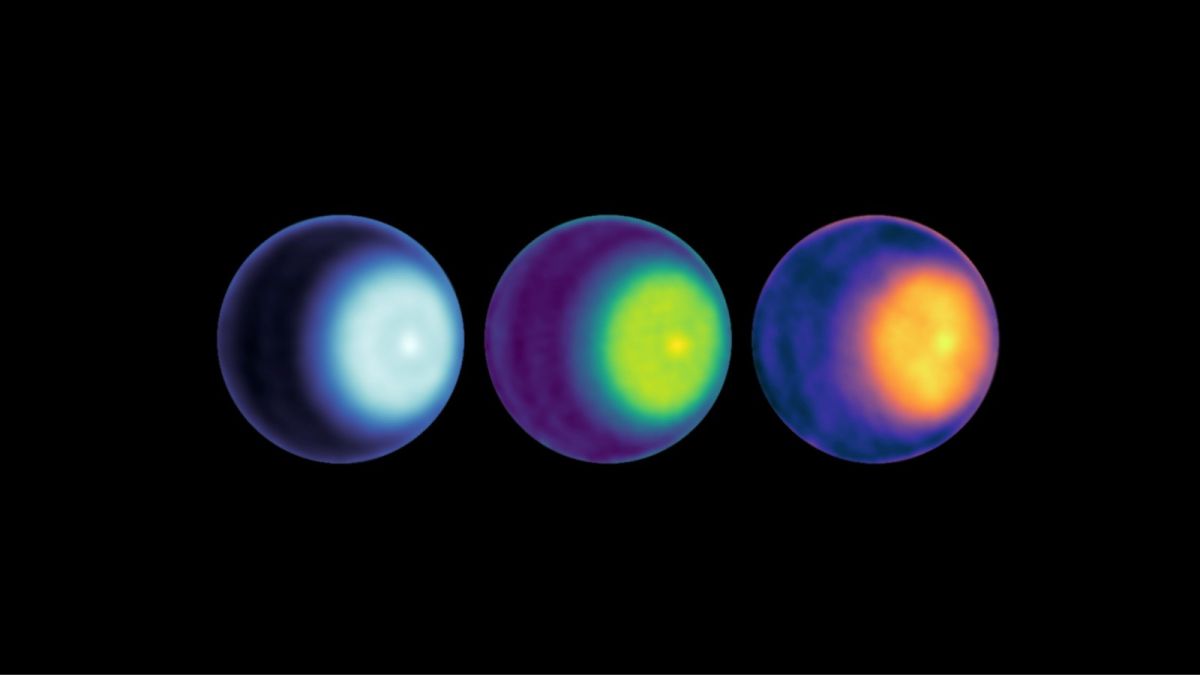A vortex of relatively warm air has been detected swirling beneath Uranus’ clouds, providing strong evidence for the existence of a cyclone anchored at the planet’s north pole.
The findings add fuel to the fire that Uranus is not as atmospherically inert as it initially seemed when NASA’s Voyager 2 spacecraft flew past the “ice giant” in January 1986.
The discovery of a northern vortex on Uranus was made through the detection of thermal emission in the form of radio waves picked up by astronomers using the Very Large Array (VLA) of radio telescopes in New Mexico.
Related: Photos of Uranus, the tilted giant planet
Polar vortices seem to be a common trait of all planets with atmospheres, at least in our solar system – they have been previously observed on Venus, Earth, Mars, Jupiter, Saturn, Uranus (at its south pole) and Neptune. High-altitude atmospheric jet streams are thought to be responsible for the formation of these vortices, although the details differ on each planet.
When Voyager 2 encountered Uranus, it detected changes in wind speeds, which can reach 560 mph (900 kph), at the planet’s south pole and which are consistent with the existence of a polar vortex there. However, Voyager 2 did not get a view of the planet’s north pole to see if there was a vortex there, too. Compounding this lack of up-close data, observing either of Uranus’ poles from Earth has been difficult until recently. This is because Uranus orbits the sun tipped over onto its side by 97.8 degrees. In essence, it is “rolling” around the sun, which meant that for a long time we could only see the planet’s equatorial region from our point of view.
Since 2015, however, Uranus has rolled around the sun enough for us to begin to get a clearer view of its north pole as the planet enters northern spring. In 2018 and 2022, the Hubble Space Telescope observed a bright, smoggy cap over Uranus’ north pole — the first evidence for a polar cyclone.
Now, observations of Uranus by the VLA, in 2015, 2021 and 2022, have measured the atmospheric circulation and temperature change in this polar cap. The VLA detected a “dark collar” ringing the planet at 80 degrees latitude, mirroring a bright collar observed by Voyager 2 around its southern pole, which is understood to be a denser part of the atmosphere. Inside this dark collar, the VLA detected a bright spot, indicating temperatures several degrees warmer in the center of the vortex than outside it (where temperatures can drop to minus 370 degrees Fahrenheit (minus 224 degrees Celsius). A bright, warmer spot like this is a very typical characteristic of a cyclone.
Imaged by the Hubble Space Telescope in 2022, here we see Uranus’ bright polar cap. (Image credit: NASA/ESA/STScI/A. Simon (NASA-GSFC)/M. H. Wong (UC Berkeley)/J. DePasquale (STScI))
“These observations tell us a lot more about the story of Uranus,” Alex Atkins of NASA’s Jet Propulsion Laboratory in Southern California, who led the observations, said in a statement. “It’s a much more dynamic world than you might think.”
Unlike Earth’s cyclones, Uranus polar vortex is not formed of water vapor but of ices of methane, ammonia and hydrogen sulfide. Nor does the storm drift, instead remaining rooted to the pole. Little else is known about it at this time.
“Does the warm core we observed represent the same high-speed circulation seen by Voyager? Or are there stacked cyclones in Uranus’ atmosphere?” wondered Atkins.
In the recent Planetary Science and Astrobiology Decadal Survey issued by the U.S. National Academies, Uranus was highlighted as a priority for a new space mission. To support this goal, planetary scientists are doubling their efforts to study Uranus to help inform the scientific goals of any future mission.
Observing and better understanding Uranus’ polar cyclones is a key scientific aim, and Atkins and his colleagues hope to continue studying the north polar vortex for many years to come to observe if and how it might change over time. Already, there are indications that the warm core has begun to brighten as northern spring has progressed.
The results of the VLA observations were published Tuesday (May 23) in the journal Geophysical Research Letters.
Follow Keith Cooper on Twitter @21stCenturySETI. Follow us on Twitter @Spacedotcom and on Facebook.
Originally posted on Space.com.
































